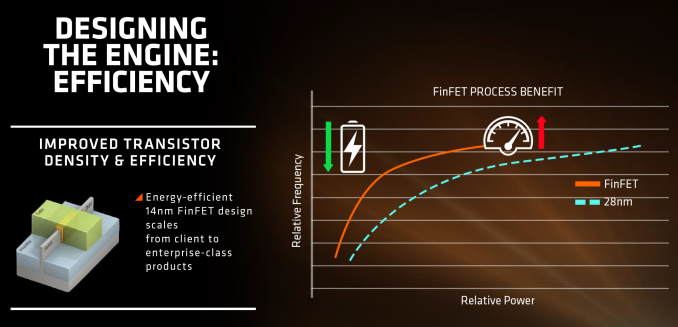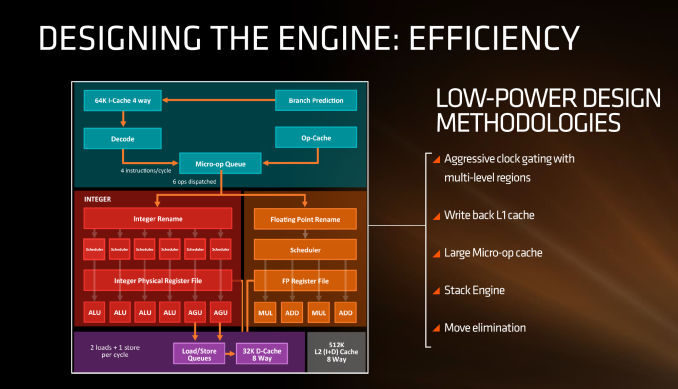AMD Zen Microarchitecture: Dual Schedulers, Micro-Op Cache and Memory Hierarchy Revealed
by Ian Cutress on August 18, 2016 9:00 AM ESTLow Power, FinFET and Clock Gating
When AMD launched Carrizo and Bristol Ridge for notebooks, one of the big stories was how AMD had implemented a number of techniques to improve power consumption and subsequently increase efficiency. A number of those lessons have come through with Zen, as well as a few new aspects in play due to the lithography.
First up is the FinFET effect. Regular readers of AnandTech and those that follow the industry will already be bored to death with FinFET, but the design allows for a lower power version of a transistor at a given frequency. Now of course everyone using FinFET can have a different implementation which gives specific power/performance characteristics, but Zen on the 14nm FinFET process at Global Foundries is already a known quantity with AMD’s Polaris GPUs which are built similarly. The combination of FinFET with the fact that AMD confirmed that they will be using the density-optimised version of 14nm FinFET (which will allow for smaller die sizes and more reasonable efficiency points) also contributes to a shift of either higher performance at the same power or the same performance at lower power.
AMD stated in the brief that power consumption and efficiency was constantly drilled into the engineers, and as explained in previous briefings, there ends up being a tradeoff between performance and efficiency about what can be done for a number of elements of the core (e.g. 1% performance might cost 2% efficiency). For Zen, the micro-op cache will save power by not having to go further out to get instruction data, improved prefetch and a couple of other features such as move elimination will also reduce the work, but AMD also states that cores will be aggressively clock gated to improve efficiency.
We saw with AMD’s 7th Gen APUs that power gating was also a target with that design, especially when remaining at the best efficiency point (given specific performance) is usually the best policy. The way the diagram above is laid out would seem to suggest that different parts of the core could independently be clock gated depending on use (e.g. decode vs FP ports), although we were not able to confirm if this is the case. It also relies on having very quick (1-2 cycle) clock gating implementations, and note that clock gating is different to power-gating, which is harder to implement.












216 Comments
View All Comments
Kevin G - Saturday, August 20, 2016 - link
Google is porting their internal software but they're not moving production system unless there is a clear reason. (And for some specific applications, there are some clear reasons.)Google doesn't want to be married to any particular architecture.
BillBear - Saturday, August 20, 2016 - link
As of April, they seem to have already ported their software stack to POWER and to be in the process of designing server hardware with Rackspace with the intention of making those designs public under the Open Compute Project.http://www.pcworld.com/article/3053092/ibms-power-...
BillBear - Saturday, August 20, 2016 - link
I should be clear that I'm not saying Google intends to abandon x86. They are simply talking about POWER based servers becoming a first class citizen in their infrastructure.TheinsanegamerN - Saturday, August 20, 2016 - link
Crossing fingers for a great 35 watt APU. The iGPU space in laptops has been stagnant since trinity. and it is abundantly clear that intel cant supply iris pro parts in any meaningful capacity.Now that AMD supports linux properly with polaris, all we need is a polaris+zen APU for laptops, and I can finally move off of windows altogether.
Michael Bay - Sunday, August 21, 2016 - link
Why would you even need a gpu in a laptop running specialized OS in the first place? Games aren`t being ported outside of token cases and rendering/drawing/general office applications are a sad joke.Networking is where it`s good at, and you don`t need anything over perfunctory graphics there.
Gigaplex - Monday, August 22, 2016 - link
Linux is quite the opposite of a specialized OS. It's probably the most versatile platform out there.Michael Bay - Monday, August 22, 2016 - link
I see it being said a lot, but what`s the point if software is so bad with no hope of improvement? You can`t reasonably compete with Adobe if there are three people on your team doing this in their spare time, same goes for Zbrush and any other professional content creation tool. Much better to focus where you actually can lead.asoltesz - Sunday, August 28, 2016 - link
"with no hope of improvement" is nonsense for one tracking the Linux world even if only casually.First of all the open source applications have matured a lot. E.g. I could do everything I wanted with Kdenlive as good as the built in movie editor of OSX. (Consumer level, bit still)
For certain niches, oss is now as good as the commercial competition (eg Krita for digital painting)
A lot of newer applications now have proper Linux support (E.g. Slack) because they were created with platform independent toolkits.
As for the base OS and desktop, I find desktop Linux way more powerful and sophisticated than either Windows or OSX. My ws runs KDE Plasma 5 on an Ubuntu base and it is better looking , faster and more stable than my OSX ElCap laptop.
BrokenCrayons - Monday, August 22, 2016 - link
Check Steam. The last time I looked, about 2,700 games of the 11,000 were supported under Linux. Then there's quite a few that play nicely under WINE + PlayOnLinux. Native gaming on Linux has dramatically improved in the last 4 years. It seems as though momentum is building still rather than declining. Office applications have come a long way as well thanks to the folks behind LibreOffice. I've been using it as a personal office suite since the fork from OpenOffice and it's made impressive progress. Formatting MS Office documents is still a minor sticking point, but the number of differences I see when moving files between office suites now are very small with most cases being oddball outliers that require obscure capabilities of Microsoft's suites. Rendering has never been a problem on Linux platforms. Drawing though, in my opinion is still a shortcoming. GIMP is a miserable piece of software to work with and remains one of the only image editing options for Linux users.However, I doubt my comment will change your mind. Much like the people who use a $ when they talk about Microsoft, you insist on using the word "loonix" in many of your posts. It shows a very strong bias supported by a framework of childish emotional investment in something as meaningless as software on a computer someone else owns.
Michael Bay - Monday, August 22, 2016 - link
>2700 indie nongamesUh-uh. Wake me up when AAA comes in any significant number.
>WINE
Are you joking.
>Libre
Okay, now I know you are.
>GIMP
At least here we can agree.